
Hafnium is a chemical element with the symbol Hf and atomic number 72. A lustrous, silvery gray, tetravalent transition metal, hafnium chemically resembles zirconium and is found in many zirconium minerals. Its existence was predicted by Dmitri Mendeleev in 1869, though it was not identified until 1923, by Dirk Coster and George de Hevesy, making it the second-last stable element to be discovered. Hafnium is named after Hafnia, the Latin name for Copenhagen, where it was discovered.
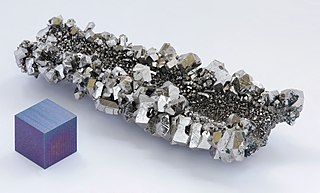
Niobium, also known as columbium, is a chemical element with the symbol Nb and atomic number 41. Niobium is a light grey, crystalline, and ductile transition metal. Pure niobium has a Mohs hardness rating similar to that of pure titanium, and it has similar ductility to iron. Niobium oxidizes in the earth's atmosphere very slowly, hence its application in jewelry as a hypoallergenic alternative to nickel. Niobium is often found in the minerals pyrochlore and columbite, hence the former name "columbium". Its name comes from Greek mythology, specifically Niobe, who was the daughter of Tantalus, the namesake of tantalum. The name reflects the great similarity between the two elements in their physical and chemical properties, making them difficult to distinguish.

Titanium is a chemical element with the symbol Ti and atomic number 22. Its atomic weight is 47.867 measured in daltons. It is a lustrous transition metal with a silver color, low density, and high strength, resistant to corrosion in sea water, aqua regia, and chlorine.

Vanadium is a chemical element with the symbol V and atomic number 23. It is a hard, silvery-grey, malleable transition metal. The elemental metal is rarely found in nature, but once isolated artificially, the formation of an oxide layer (passivation) somewhat stabilizes the free metal against further oxidation.
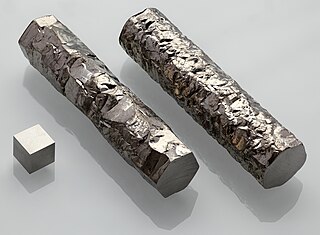
Zirconium is a chemical element with the symbol Zr and atomic number 40. The name zirconium is taken from the name of the mineral zircon (the word is related to Persian zargun, the most important source of zirconium. It is a lustrous, grey-white, strong transition metal that closely resembles hafnium and, to a lesser extent, titanium. Zirconium is mainly used as a refractory and opacifier, although small amounts are used as an alloying agent for its strong resistance to corrosion. Zirconium forms a variety of inorganic and organometallic compounds such as zirconium dioxide and zirconocene dichloride, respectively. Five isotopes occur naturally, four of which are stable. Zirconium compounds have no known biological role.
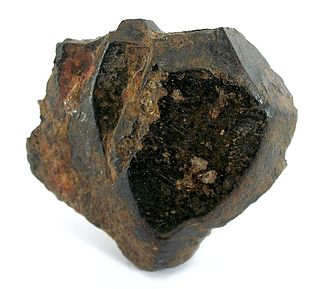
Ilmenite is a titanium-iron oxide mineral with the idealized formula FeTiO
3. It is a weakly magnetic black or steel-gray solid. From a commercial perspective, ilmenite is the most important ore of titanium. Ilmenite is the main source of titanium dioxide, which is used in paints, printing inks, fabrics, plastics, paper, sunscreen, food and cosmetics.
A period 4 element is one of the chemical elements in the fourth row of the periodic table of the elements. The periodic table is laid out in rows to illustrate recurring (periodic) trends in the chemical behaviour of the elements as their atomic number increases: a new row is begun when chemical behaviour begins to repeat, meaning that elements with similar behaviour fall into the same vertical columns. The fourth period contains 18 elements beginning with potassium and ending with krypton – one element for each of the eighteen groups. It sees the first appearance of d-block in the table.

Cryolite (Na3AlF6, sodium hexafluoroaluminate) is an uncommon mineral identified with the once-large deposit at Ivittuut on the west coast of Greenland, depleted by 1987.
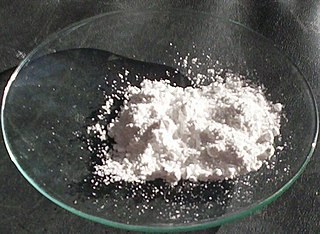
Titanium dioxide, also known as titanium(IV) oxide or titania, is the inorganic compound with the chemical formula TiO
2. When used as a pigment, it is called titanium white, Pigment White 6 (PW6), or CI 77891. It is a white, water-insoluble solid, although mineral forms can appear black. As a pigment, it has a wide range of applications, including paint, sunscreen, and food coloring. When used as a food coloring, it has E number E171. World production in 2014 exceeded 9 million tonnes. It has been estimated that titanium dioxide is used in two-thirds of all pigments, and pigments based on the oxide have been valued at $13.2 billion.

Group 4 is the second group of transition metals in the periodic table. It contains the four elements titanium (Ti), zirconium (Zr), hafnium (Hf), and rutherfordium (Rf). The group is also called the titanium group or titanium family after its lightest member.

Martin Heinrich Klaproth was a German chemist. He trained and worked for much of his life as an apothecary, moving in later life to the university. His shop became the second-largest apothecary in Berlin, and the most productive artisanal chemical research center in Europe.
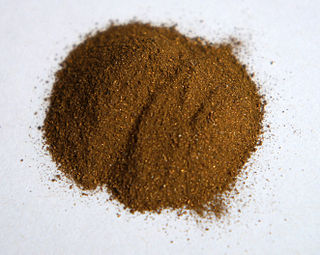
Titanium nitride is an extremely hard ceramic material, often used as a coating on titanium alloys, steel, carbide, and aluminium components to improve the substrate's surface properties.
Titanium(III) oxide is the inorganic compound with the formula Ti2O3. A black semiconducting solid, it is prepared by reducing titanium dioxide with titanium metal at 1600 °C.

Organotitanium compounds in organometallic chemistry contain carbon-titanium chemical bonds. Organotitanium chemistry is the science of organotitanium compounds describing their physical properties, synthesis and reactions. They are reagents in organic chemistry and are involved in major industrial processes.

Calcium titanate is an inorganic compound with the chemical formula CaTiO3. As a mineral, it is called perovskite, named after Russian mineralogist, L. A. Perovski (1792-1856). It is a colourless, diamagnetic solid, although the mineral is often coloured owing to impurities.

The Point Lookout Sandstone is a Cretaceous bedrock formation occurring in New Mexico and Colorado.
Wassonite is an extremely rare titanium sulfide mineral with chemical formula TiS. Its discovery was announced in a 2011 NASA press release as a single small grain within an enstatite chondrite meteorite called "Yamato 691", which was found during a 1969 Japanese expedition to Antarctica. This grain represents the first observation in nature of the synthetic compound titanium(II) sulfide.
The Yamato 691 is the 4.5 billion year old chondrite meteorite discovered by members of the Japanese Antarctic Research Expedition on the blue ice field of the Queen Fabiola Mountains in Antarctica, on December 21, 1969.
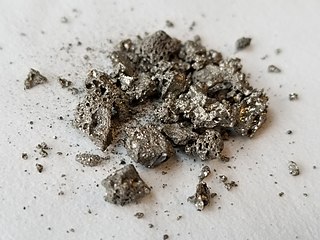
Cobalt(II) selenide is an inorganic compound with the chemical formula CoSe. The mineral form of this compound is known as freboldite. Similar minerals include trogtalite (CoSe2) and bornhardtite (Co2+Co3+2Se4).
Kenzō Yagi was a Japanese mineralogist and petrologist who specialized in experimental mineralogy and petrology. Yagiite, a new mineral found in the Colomera meteorite, was named after him for its contribution to the petrology.














